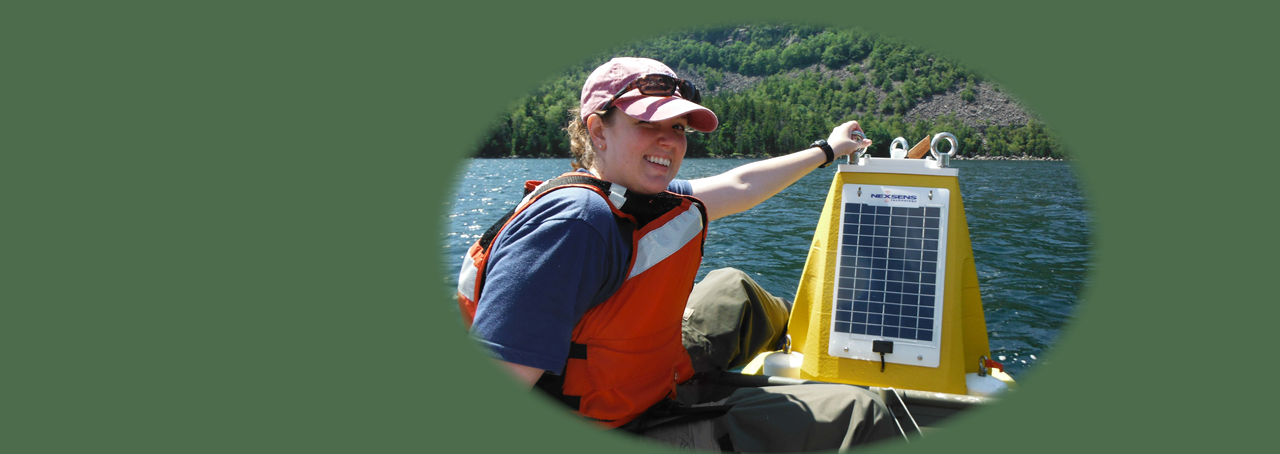SUNY-based collaboration explores “big data” approach to study New York lakes
A new SUNY-wide collaboration owes its existence to a chance meeting at an international conference.
Last fall, hydrogeologist Devin Castendyk, SUNY Oneonta, and biologists Courtney Wigdahl-Perry, SUNY Fredonia, and David Richardson, SUNY New Paltz, attended a GLEON (Global Lake Ecological Observatory Network) conference in Quebec, Canada, where scientists, educators, and policymakers met to share and interpret high-resolution sensor data in order to study how lakes react to a changing global environment.
None of the three SUNY professors knew each other, nor did they know that other SUNY faculty were there. Fortunately, the conference provided a lot of networking time, and the trio got to talking about their work.
After brainstorming, they decided to launch a project of their own, modeling it after GLEON and calling it the SUNY Lake Ecological Observatory Network. Its purpose is to establish a SUNY-based collaboration to study the lake systems of upstate New York. “We thought, wouldn’t it be neat to make our own network by installing buoys in Chautauqua Lake in western New York, Otsego Lake in central New York, and Mohonk Lake in eastern New York. That way we’d have a network of sensors at a similar latitude going right across the state,” says Castendyk.
The project, still in an early stage, has received seed money from the SUNY Networks of Excellence. The three principal investigators (PIs) hope to secure additional funding that will allow them to purchase three sensor buoys to collect data; establish a collaborative SUNY working group; build community connections with local organizations and community colleges at the lake sites; and seek membership in GLEON.
“The real key for us is building the collaboration between our institutions in order to connect with the local communities,” says lead PI Wigdahl-Perry. “We want to make sure we’re putting this information back into the hands of community members and lake management people.”
When Wigdahl-Perry says “information,” she means it. Once the buoys are in place, they’ll be collecting data such as water temperature, pH, surface wind, and the like every fifteen minutes, 24/7. The information will be conveyed to servers and put online for anyone to use. Such a huge data set is rare for this type of research, where scientists typically collect data once a month.
Richardson uses a familiar metaphor to explain why they’re taking a different approach: “If you could only check your email once a month, you’d be missing a lot that was happening on a smaller time scale. It’s the same with ecological research; if we only go out once a month or once a week, we’re missing things that are happening within a day and patterns that accumulate over time.”
The more data the study can gather, the better stakeholders can manage environmental resources and the more the researchers can look at impacts caused by various land uses. They are even hoping to eventually look at climate change. With enough data, they’ll be able to look for very subtle trends in water temperature, lake mixing, or a variety of other parameters.
Large data sets such as these are referred to as “big data,” and they are of great interest to contemporary science because they allow investigators to propose questions that were previously moot.
In this study, a large data set also offers a wide range of possible research topics to SUNY students. Some might investigate how storm events move from west to east across New York by tracking them through the effect of wind on the water column at each buoy. Others may choose to focus on one of the three lakes, each of which presents a different set of issues due to variations in invasive species or land use.
Castendyk points to the opportunities inherent in the richness of their data set: “It’s open-ended, as opposed to there being only one project that could be done. We’re creating something that will be utilized throughout the SUNY network, and once we tie it in with GLEON, a university professor in New Zealand could access our data and come up with her own activities.”
Big data is also of interest to the business community. Having students work with it provides them with opportunities beyond the science itself. According to Wigdahl-Perry, “On this project, students will be learning to deal with data points coming from multiple sensors every fifteen minutes. They’ll be managing it, pulling out interesting facts, and identifying trends, so there’s lot of training opportunities beyond just working with aquatic ecosystems.”
Students will derive a further benefit from the project: its collaborative bent will give them the opportunity to work with stakeholders such as lake managers, people who live around the lakes, and students from other institutions. “That’s what they’re going to be doing as they go forward as biologists, ecologists, geologists,” Richardson asserts, pointing out that interacting with people and explaining the data are mainstays of many environmental science jobs, whether in academia, research, or a governmental organization like the Department of Environmental Conservation.
As the Internet connects scientists around the world, the scientific endeavor itself is becoming more collaborative. One look at the GLEON website reveals the benefits of global scientific cooperation. A look at the SUNY Lake Ecological Observatory Network reveals it, too.
comments powered by Disqus


